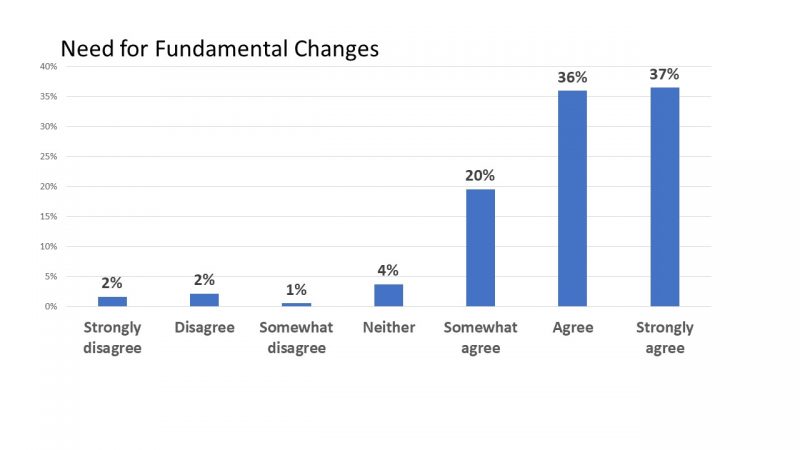Survey Reveals Disconnect Between Current Strategies and Market Realities

Is it déjà vu? Back in 2018, my business partner, Kevin Ordonez, and I wrote a book. It was the result of months of thinking about how associations would need to change in the digital age. When we named our work, Association 4.0: Positioning for Success in an Era of Disruption, little did we suspect, that in short order, our entire community would be living that title.
Fast forward to Solutions Day 2020, .orgCommunity’s signature event. I presented the results of a survey that .orgSource conducted to assess the impact of that disruption. The pandemic has accelerated many of the trends .orgSource was already seeing on the horizon and has brought challenges that were hiding in plain sight into perspective. I didn’t expect to be surprised by our results. But there were several unanticipated findings.
Our Goals
We initiated the project with these goals in mind:
- Explore the strategies and tactics associations are developing in response to COVID-19.
- Identify which changes will have a lasting impact on participants’ business models, culture, structure, systems, and human and financial resources.
- Learn how associations are enhancing resilience and strengthening their ability to face uncertainty and future challenges.
The survey was distributed in late July and ran through early August. Close to 300 association executives participated. Following is the demographic profile:
- 61% were from professional associations, 25% were from trade associations, and 14% were from some other type of non-profit or governmental organization.
- Three-quarters were members of the senior management team.
- Half had budgets less than $5 million, and one-fifth had budgets over $15 million.
Unexpected Contradictions

The survey highlighted two divergent points of view. As anticipated, most leaders understand that COVID-19 is creating significant shifts in the current association paradigm. A total of 73% of participants agreed, or strongly agreed, that the pandemic is accelerating trends that will require fundamental changes in the role of associations, their underlying business model, and their strategic direction. Also, 54% strongly agreed that shifts in the environment will threaten the viability of many groups.
Here is the disconnect. A surprising number of participants do not anticipate, and are not considering, the need for any significant post-pandemic change. Just under half, or 40%, did not foresee any long-term revisions to their product portfolio. Almost 60% believe their membership models will resume pre-pandemic patterns, and 41% saw in-person networking opportunities returning to the status quo. Many participants also commented that their mission and vision would remain unchanged.
I have to question whether these assumptions are realistic given the strong countervailing trends. For several years, we have seen that:
- The traditional membership model isn’t the best fit for today’s workers or their employers.
- The digital marketplace has conditioned buyers to expect customized products that are available 24/7 and delivered on-demand.
- We don’t know when the need for social distancing will end, and the low-touch economy has ushered in new ways and venues for connecting and networking.
I think these findings indicate that the association community has adjusted to the superficial aspects of change. Although there were challenges to remote work and virtual meetings, we made the leap because there was no choice. But we have not come to terms with the deeper shifts in psychology, preference, and delivery that are moving the digital marketplace. I am still singing the same tune I was before the pandemic. Technology is not just reinventing goods and services; it is reshaping culture. Associations must scrutinize their fundamentals. Leaders need to critically examine their organizations’ reason for being and the underlying business model that supports that mission.
The Glass is Half Full
Although the numbers are a weak endorsement for lasting change, data also indicates that associations are adopting attitudes that support innovation and action; even if they don’t appear to be ready to significantly transform. Forty-two percent of participants reported becoming more action-oriented and nimble, and 34% indicate that they are collaborating more frequently with others.
This positive news is reinforced by the fact that even before the pandemic, forward-thinking executives were introducing the strategies needed to navigate a digital environment. CEOs we interviewed for our book had already adopted these tools for success:
- Remote work
- Freelance support
- Cloud computing
- Better use of video and virtual technologies
- Marketing automation
- AI
- Digital transformation
Organizations that were using technology effectively were relatively unfazed by the pandemic’s disruption.
The Glass is Half Empty
The bad news is that leaders don’t appear to believe that volatility will be a permanent condition or that they must prepare for other disruptions. Of total participants, only:
- 13% are investing in skills for the future
- A quarter reported having a vision for the future
- 24% have a plan that will generate sustainable profitability
- 13% felt their associations were diversifying revenue successfully
Overall, the most frequent concerns were having data to make good operational and financial decisions, monetizing and attaining profitability for online education and events, and diversifying revenue sources.
With in-person conferences representing a significant share of association profits, the concerns surrounding revenue are not surprising. Results from virtual events have been mixed. Respondents reported considerable variation between the amount of participation and the return on investment. Twenty-four percent said their organization had experienced a decline in participation of more than 15% and a proportional 27% experienced an increase of 15%. Revenue is more problematic. Forty-eight percent reported a net decline of more than 15%, and only 12% saw an increase of more than 15%. The fact that increases in participation did not necessarily translate into increases in revenue, points to a need for more strategizing and innovation in this area. Events can’t do all the financial heavy lifting. There is a need for diversified product portfolios.
The reluctance to view the pandemic as a springboard to future innovation may mean that associations are challenged to acquire the resources to make significant shifts in approach. When we asked about the key building blocks for change only 25% agreed that their organizations had these qualities:
- Clear vision
- An operational plan to achieve profitability
- Adequate technology
- Information resources or business intelligence systems
- A digital strategy to support innovation
The Whole 8 Ounces
I was grateful that so many people took the time to give us a snapshot of what’s happening in their organizations. These are the six findings that we view as most significant:

I am encouraged by our community’s ability to pivot and adapt to remote work, virtual meetings, and the cultural and economic stresses of the pandemic. But I wish that the situation was a call to action for the future. The lack of building blocks for change is cause for concern. In my consulting business organizations are facing these challenges:
- Limited collaboration and communication among remote teams
- Technology silos that make data-driven decisions difficult
- Lack of technology integration and weak online customer experience
- Governance structures that impede agility and the ability to pivot
- Cultures not grounded in trust
- Low priorities for innovation
- Reluctance to acknowledge change and uncertainty
These problems can be fixed. But they are also issues that, amid many competing priorities, are easy to sweep under the carpet. Don’t hide the dust; eventually, it will cause you to stumble or fall. Instead, take a methodical approach to addressing whatever is holding your group back. .orgSource has identified these seven areas where we guide organizations through transformational change:
- Management commitment
- Readiness
- Strategy
- People
- Processes
- Technology
- Successful implementation
If you’re not ready, or able, to undertake this comprehensive approach to organizational health, remember every step forward is progress. Don’t be paralyzed by the fact that you can’t run a marathon. Identify the places where you can improve easily and take action. Acknowledge where progress will be difficult and build critical resources. This will not be the last disruption. The small steps that you take to position your organization for success today are building blocks toward a stronger future.
Members of .orgCommunity can download, Creating the New Normal Survey Report 2020, for free in the .orgCommunity Member Discussion Forum Files or at the .orgCommunity store.
Share your thoughts
What is the best decision your organization made during the pandemic?
What was your biggest misstep?
What has been most challenging for you professionally?

